How to Store Potatoes for Winter
This post may contain affiliate links, which means that I may receive a commission if you make a purchase using these links. As an Amazon Associate I earn from qualifying purchases.
Potatoes can last for months in storage under the right conditions. Learn when to harvest potatoes, how to cure them properly, and how to store potatoes for winter with these tips.

Potatoes are a staple food for many cultures around the world. Potatoes are a very versatile vegetable that can be used in everything from soups to side dishes. They are inexpensive to grow, packed with nutrition, and can be stored for a lengthy period of time.
Long before modern supermarkets, potatoes were traditionally grown or purchased in fall, and stored in root cellars for winter meals. A root cellar is an underground structure that is protected from freezing temperatures, but maintains cool and humid conditions ideal for holding foods for months after harvesting.

Most of us don’t have root cellars anymore, but we can still use the same principles to store crops in winter in our modern homes.
I have an unheated corner in my basement that is perfect. This corner stays dark, cool, and performs like a root cellar. I have added shelving where I store the foods preserved from the vegetable garden during the growing season. Once fall arrives, the shelves are filled with home canned goods and winter storage crops.
A basement keeps a steady temperature and is cooler than the rest of the house. If you don’t have a basement, consider any location that stays above freezing through the fall and winter, such as your crawlspace, garage, mud room, bulkhead, under the back porch, or even a closet.
How to Harvest Potatoes
If you are growing potatoes for winter food storage, let the tubers develop fully in the ground. Mature potatoes are less likely to bruise when harvesting than immature potatoes, and will last longer in storage. Here are tips for harvesting potatoes for winter food storage:
Let the Potatoes Mature Fully
Potatoes are finished growing when the foliage starts turning yellow. Stop watering at this point and let the foliage die back. During this time, the skins of the potatoes will thicken and toughen up. This will help protect the tubers from damage when they are harvested.
Check your crop by digging up a few potatoes from the edge of your potato patch. Rub the skin with your thumb. If the skin is paper-thin and rubs off easily, the potatoes are not ready yet. Give them a few more days under ground, and then check them again.

Dig Up the Potatoes
Your potatoes are ready for harvesting once the plants have died back, and the skins have firmed up and no longer rub off easily.
Harvest the potatoes on a warm, dry day after a period of little or no rain. Digging by hand is the best way to avoid damaging the potatoes.
Use a digging fork to loosen the soil beneath the potatoes. Then sift through with your hands and pull out the tubers. Place your potatoes carefully in buckets or bins. Try not to bruise or damage the skin or the potatoes will not last long in storage.
If you are harvesting on a sunny day, place the buckets in the shade after filling because sunlight will turn the potato skins green. There is no need to wash the potatoes after harvesting, just keep them dry and out of direct light.
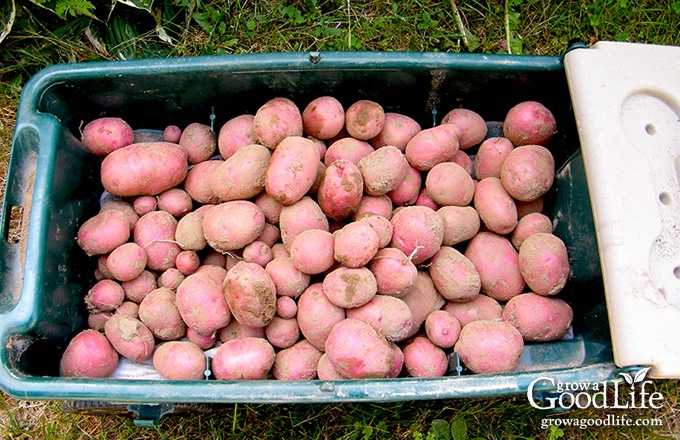
Separate Damaged Tubers
Occasionally, you will come across potatoes that were damaged by moles or voles underground, or you may accidentally stab one with the digging fork. Keep blemished potatoes separate from your storage potatoes because they are more likely to rot and possibly infect the rest of the tubers. Trim off the damaged areas and eat these first.
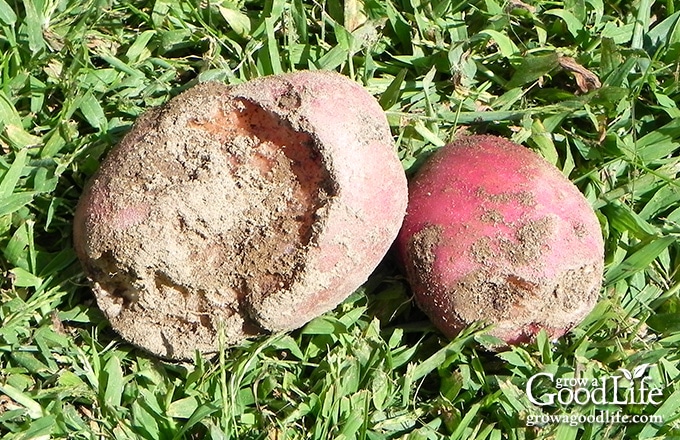
Tips for Storing Potatoes Long Term
Whether you grow your own, or stock up at your local farmers’ market, select varieties known for their long-term storage capabilities. The OSU Extension Service recommends the following varieties: Elba, Katahdin, Red Chieftain, Yukon Gold, Burbank Russet, German Butterball, Yukon Gem, Rose Finn Apple Fingerling, Russian Banana Fingerling, Red Pontiac, All Blue, and Kennebec.
If you are purchasing potatoes from a farmer’s market in fall or winter, ask the growers which varieties they recommend for storing. In addition, find out when they were harvested, and if they need to be cured before storing.
Don’t worry if your variety is not on the list. Other varieties may not last all winter, but most potatoes will last at least a month or two when stored under the proper conditions.
You may be wondering if you can store potatoes purchased at a grocery store all winter in the same way. The answer is…it depends.
Commercially grown potatoes are harvested, cured, and stored in special environment controlled refrigeration buildings until they are ready to ship. Then they are sorted, packaged, boxed, shipped to warehouses, and then finally trucked to your local grocery store.
During this time, the tubers experience temperature fluctuations and exposure to light. It is likely the potatoes already have broken dormancy before reaching the supermarket shelves. However, you can still store grocery keep potatoes fresh for at least a few months using this method. Be sure to remove them from their plastic bags before storing, and follow the storage steps below.
5 Steps to Storing Potatoes for Winter
Once you have harvested your potato crop, you will need to find a suitable storage area and prepare the tubers for storage. Follow the steps below to prepare and store potatoes:
Step 1: Sort the Potatoes
Sort your potatoes by variety. Since some types of potatoes will last longer in storage than others, sorting by variety will make it easy to find the ones that have a shorter storage life and use these first.
I grow two varieties of potatoes: Dark Red Norland and Kennebec. Kennebec lasts much longer in storage, up to 6 months. The Dark Red Norland often begin softening and sprouting after several months, so we consume the red potatoes first.
As you are sorting, look over the potatoes carefully and pull out any with bruises or signs of damage. Tubers with broken skin, cracks, or soft spots should be separated and used immediately because these will not store well.
Green potatoes should be tossed out because they will taste bitter, and if eaten in large quantities, may cause illness. Small spots can be trimmed off, but if there is significant greening, throw the potato out.
Step 2: Cure the Potatoes
Curing your potatoes will help heal small wounds, and toughen up the skin to form a protective shell that extends the storage life. To cure your potatoes, simply spread out the unwashed tubers in a single layer in seedling trays or shallow boxes lined with newspapers.
Cover the trays with a dark towel to eliminate light, but allow air to circulate. Let the potatoes cure for several weeks in an area that is between 50 to 60˚F.
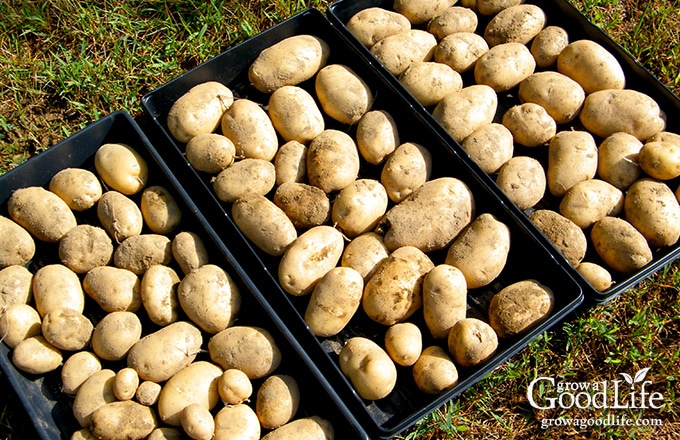
Step 3: Identify an Area Suitable for Storing Potatoes
While your potatoes are curing, locate an area in your home to store the potatoes. Ideally, potatoes should be stored in a dark, well-ventilated area at 45˚F to 50˚F (7˚C to 10˚C). The relative humidity should be around 95% to prevent the tubers from drying out. The ideal storage area for potatoes is one that is:
- Dark: Store potatoes in a dark place. Exposure to light will trigger chlorophyll to be pulled to the surface and form solanine. Chlorophyll will turn the tuber green, but solanine will give potatoes a bitter taste, and can cause illness if eaten in large quantities.
- Good Ventilation: Potatoes are still alive and continue breath after harvesting. They need to stored in an area with good airflow so they can use oxygen and give off carbon dioxide while in storage. A small fan will work for areas with no air movement.
- Cool: Keeping potatoes cool slows the growth of disease organisms that will cause the tubers to spoil. 45˚F to 50˚F (7˚C to 10˚C) is the sweet spot. If the temperature is too cold, the starch in the potatoes will convert to sugar and turn tubers dark. Warmer temperatures will also trigger the potatoes to sprout.
- Humid: Potatoes contain 80% water, and need to be stored in a damp area to prevent the potatoes from drying out. 95% is the ideal humidity level, but understand that this may not be achievable for most home environments. You can increase the humidity using a humidifier, or by placing large pans of water near your air source.
Suggested home storage locations include an unheated basement, spare closet, shed, crawlspace, or garage. Any area you choose should be insulated to protect the potatoes from freezing temperatures.
Don’t worry if your storage area is not perfect. Even if you don’t have the ideal storage conditions, as long as it is relatively cool and stays above freezing, you probably still can store your potatoes for a period of time. It is worth exploring to test it out to see how long your potatoes last in your unique storage conditions.
Step 4: Pack Up the Potatoes
After curing, store the potatoes in a dark area in covered boxes or bins with some holes for ventilation. Don’t wash the potatoes before packing because the moisture will encourage mold and reduce the storage life.
I store my potatoes in recycled paper boxes nestled in shredded paper recycled from bills and other paperwork. I cut a few holes in the sides of the boxes for air circulation, add a layer of shredded paper, and spread out the potatoes, cover with more shredded paper, and continue until the box is full.
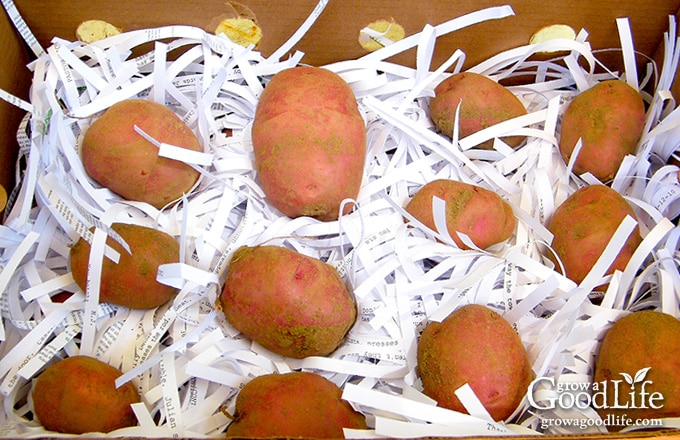
As you pack up your potatoes, lightly brush off excess dirt and inspect them once again. Small or damaged tubers should be separated and used immediately instead of stored.
Once the cardboard box is full, add the cover, label, and store in your cool, dark area. Again, ideal storage conditions for potatoes are at 45˚F to 50˚F (7˚C to 10˚C) and 80-90% relative humidity. Potatoes can last 4-9 months in storage depending on the variety.
Store potatoes separate from onions, bananas, and other fruits. These give off ethylene gas that can cause your potatoes to sprout prematurely.
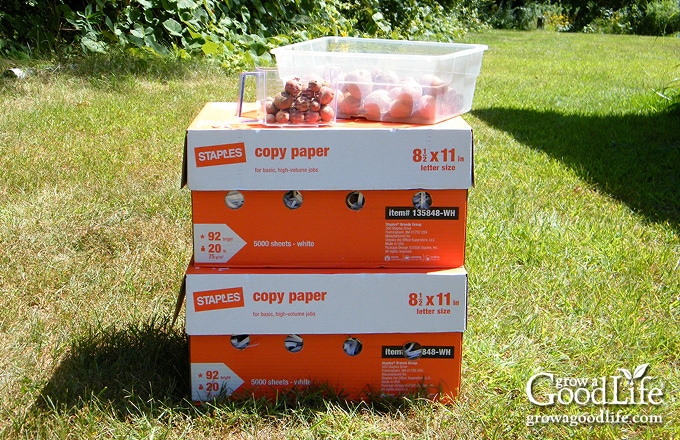
Step 5: Check on the Stored Potatoes
Every few weeks, look through the boxes to remove any potatoes that may begin to rot. Usually you can tell by the scent if there is one in the box. If you notice a musky, sour dirt smell, you should look through the box to remove the rotten potato before it infects the others.
Keep a thermometer near the potatoes so you can note any changes in temperature. Keeping the potatoes cool will slow the sprouting process, but eventually small sprouts will appear. The potatoes are safe to eat if they are still firm, simply remove the sprouts before cooking.
Potatoes may develop a sweet taste if storage temperatures dip below 40˚F. The cold temperature triggers the starches to convert to sugars. While the sugar may help the potatoes brown well when roasted or fried, too much sweetness can change the flavor. Luckily, you can reverse this process by moving the tubers to a slightly warmer location for several weeks before using in your recipes.
Trim off potato skin that has turned green. If the green has penetrated into the potato, throw it away. It is not worth the risk of making your family sick.
Under the ideal storage conditions, potatoes can remain fresh for 3 to 6 months or longer. Ours often last until spring before they begin sprouting. Sprouted potatoes can be planted in spring, as long as they look healthy and the previous season was disease free.
—
So there you have it, your quick start guide to storing potatoes for winter. The most important things to remember, is potatoes store best in a well ventilated, cool, dark, and humid environment.
Other Ways to Preserve Potatoes
The easiest ways to preserve potatoes is to store them in a root cellar or cool area of your home. However, if your storage environment is not ideal, here are other ways to preserve your potato harvest:
Potato Recipes:
- How to Make Fluffy Mashed Potatoes
- Roasted Root Vegetable Medley
- Harvest Hearty Beef Stew
- New England Fish Chowder
- Tourtiere: French Canadian Meat Pie
You May Also Like:
Want to Learn How to Grow Potatoes?
You will find everything you need to start growing potatoes in my PDF eBook, Grow a Good Life Guide to Growing Potatoes. Whether you are striving for a few gourmet fingerling potatoes or a large crop for winter food storage, this guide will show how you can grow your own, organic, homegrown potatoes.

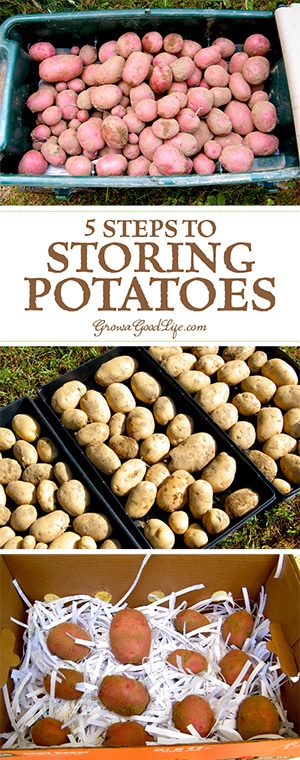
I recently discussed root cellaring as part of the vegetable class I was teaching, and a man asked why his father had always put little containers of lye at the end of each board in the root cellar where he stored his potatoes. I can’t find anything about using lye in root cellars. Do you have any ideas?
Lynn, Maybe he meant lime? Containers of hydrated lime were often used to help adjust root cellar humidity levels.
You state two different temp ranges for storing….first 45 to 50 degrees , then later it says 32-40. Which is it???
Mine store well at 45˚F to 50˚F (7˚C to 10˚C).
The coolest my basement gets is about 65 degrees. Does this make it too warm to successfully store the potatoes? All other conditions are ok—darkness, humidity, etc.
Nancy, Unfortunately, potatoes will not last long when stored at 65 degrees. Our home is between 60 and 68 in winter, and potatoes in my kitchen pantry usually last about 4 weeks before the tuber begins getting soft and growing eyes.
Potato tubers are still alive and they breathe. Lower temperatures place the potatoes in a dormant state. Warmer temperatures increase respiration, causing moisture to evaporate and the potatoes to shrivel.
The only way to know for sure is to experiment. Try storing a small batch of organic, untreated potatoes at 65 degrees and see how long they last.
There are other ways to preserve potatoes including canning and freezing.
I live in SE Louisiana, where we get a lot of rain and the weather doesn’t turn 40 degrees until December or January. No basements in our area. Potatoes are dig in June in our area, from them till October, temps go into the high 80’s too 100 degrees during the day. We love potatoes and would love to have a root cellar but we have a very high water table and lots and lots of rainy weather! We do not have any way to keep any part of the house, except the refrigerator as cold as 40 degrees and that gets a lot of light from normal usage and not much room for potatoes. I would love to build a cement root cellar above ground, but have no way to keep it cool! Any ideas?
Cecile, You really need an area that is naturally cool and dark to store potatoes. The only thing I can suggest is planting potatoes in the fall and allowing them to stay in the ground as long as possible.
You could try building an above ground cellar by using 12 inch cinder block filling them with insulation and then laying up the outside with river rock or field stone. make sure you have a well insulated door.
I live in North Louisiana, not much different. I don’t try to store raw potatoes for long term. I par-cook and freeze some as new potatoes. Other larger potatoes, I let them dry out and season in the dark, cardboard box works, then wash and boil, refrigerator first, then vacuum package in foodsaver, then freezer for use in the winter. Of course, I would grow more potatoes if I lived where I could have a root cellar, but I take advantage of modern convenience like foodsaver and deep freezers.
My question regarding curing potatoes is where in the world do you find a cool, dark place with high humidity to cure them in. I don’t have a basement or root cellar and my potato crop is already ready for harvest (June 25). I think dehydrating of canning is my only option, which is a drag as i’d love to be able to keep them in storage. I’m in zone 8b in Arizona and don’t have a root cellar either.
I wish I had an easy answer. You really need an area that is naturally cool and dark to store potatoes. You could try to time your potatoes to finish growing later in the season. Then let the potatoes stay in the ground and harvest as needed. Otherwise, canning is probably your best option.
What do u suggest for a 1000 lb crop of Kennebec I usually let them dry and put them in burlaps bags any other suggestions
Pam, That is an amazing amount of potatoes. Burlap bags are a great way to store potatoes. Just keep them in a dark place. The burlap is breathable and can let some light in. Discard any potatoes that turn green.
Hi! Do you have any issues with rodents getting in your root cellar? I have the prefect set up for a root cellar in our basement in our 100 year old house. But the construction of the house and area has led us to get mice in the basement. We bait but they still get in time to time. Would putting cardboard boxes in a large plastic cabinet mess up the amount of air flow needed for the potatoes? Thanks!
Sarah, I do get mice from time to time in our old house. The cats keep them in check. They haven’t got into my storage foods. The best defense is to keep the food up and away from the floors and walls. As long as your cabinet has some ventilation, placing the boxes in the cabinet will help keep the mice away. Mice can get into tiny holes, so use hardware cloth on your vents to prevent the mice from finding a way in.
How do we cure them?
Hi Ange, Cure potatoes in a cool and dark area by spreading the tubers out into seedling trays lined with newspaper. I cover the trays with a dark towel to eliminate light but allow air to circulate and let them cure for several weeks.
I have a hole 2 feet deep in the ground line it with plastic and straw fill it up with potatoes and cover it with straw and 10 ” of dirt I eat potatoes ontl Marchbraum van New Mexico
That sounds like a great storage system. Thanks for sharing.
I just sent that article home to my husband. He’s stuck with the potato harvest this year while the kids and I are with family out west. Thank you for the great tips!
The article on potatoes, referring to storage, I don’t have a basement and we get some snow which means temps sometimes dip to 30 degrees. What would be your suggestion for me on storing potatoes.
Ideally, potatoes should be stored in a dark environment at about 45˚F to 50˚F. Even if you don’t have these conditions or a basement, you can still store potatoes for a while. Do you have a garage, or unheated nook or closet in your home? Some place that stays pretty cool and dark but doesn’t get below freezing? Mother Earth News has some other ideas too in this article: http://www.motherearthnews.com/organic-gardening/food-storage-zm0z12aszcom.aspx#axzz3ELccIU9q
my father and grandpa dug small hole in garden close to house lined it with plastic covered with leaves and then mounded it up with dirt ( for turnips would it work for potatoes